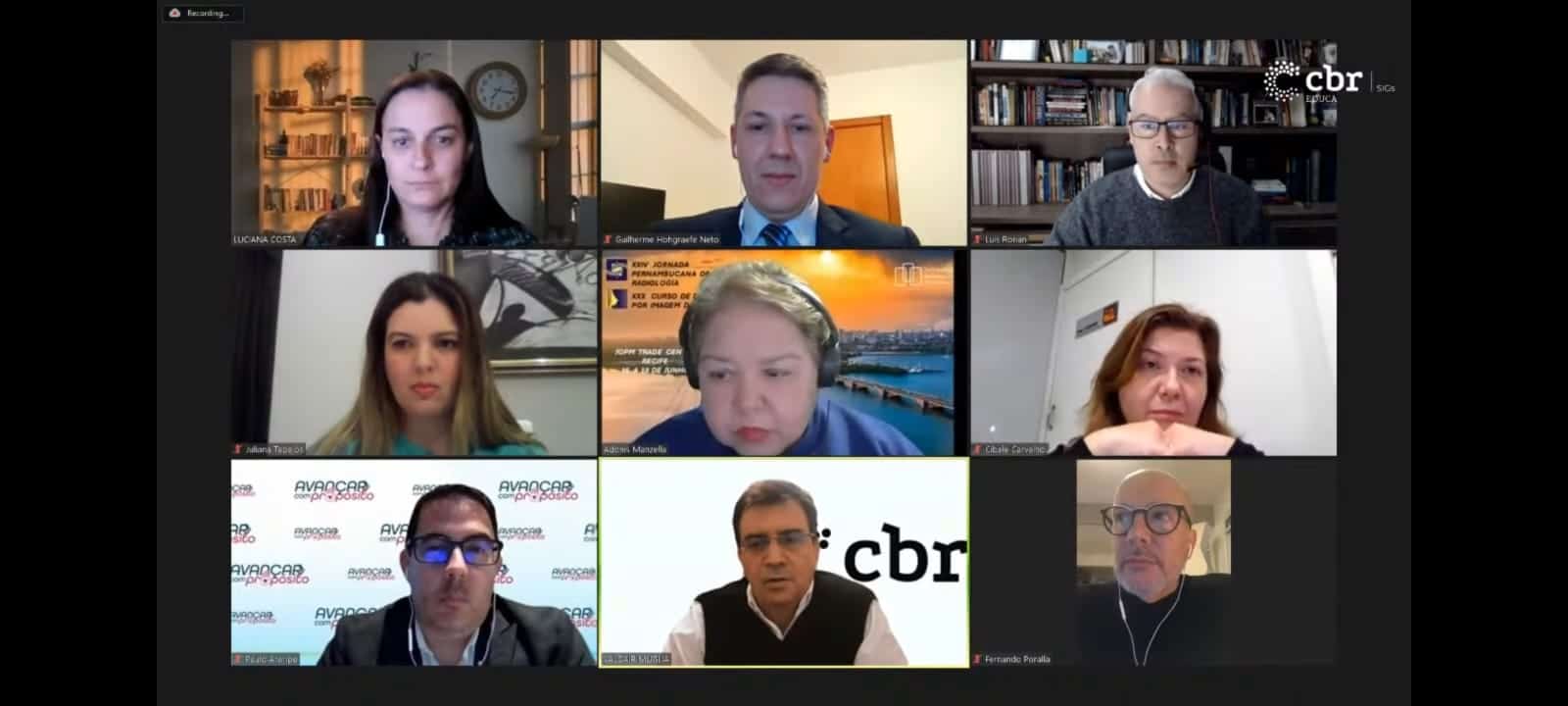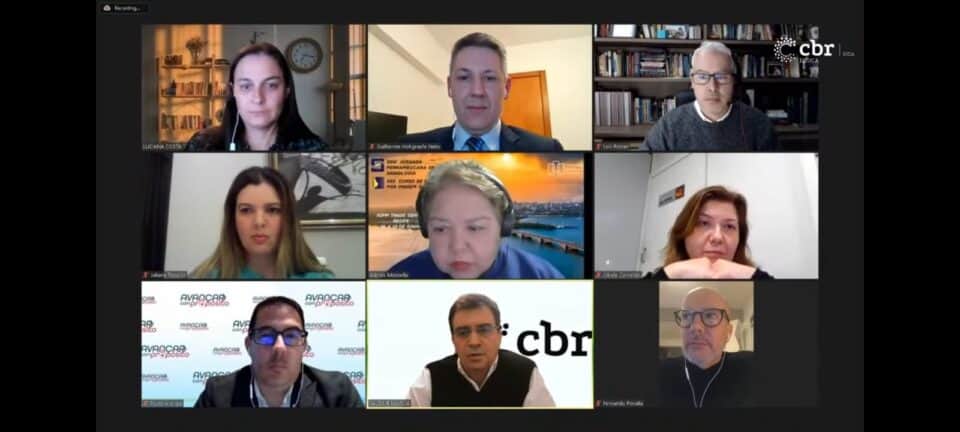The president, Valdair Muglia, and directors of the Brazilian College of Radiology and Diagnostic Imaging (CBR) met online, on Tuesday night (06/14), to discuss “Strategies to manage the shortage of contrast media in Radiology”. The webinar presented data on the current international scenario, mainly caused by the worsening of the Covid-19 pandemic in China, alternatives and strategies for managing the use of contrast, with a lecture by Guilherme Hohgraefe Neto, specialist in Radiology and Imaging Diagnosis by CBR and AMB, full member of the CBR and of the Accreditation Commission in Diagnostic Imaging (Cadi) of the College (check out highlights below).
The problem has grown across the world in recent months. Concerned about the situation in the country, the CBR consulted radiologists and companies, issued a note on the issue in May and brings clarifications and alternatives through the webinar, which is available on official channel of CBR on Youtube and in the video below. “We cannot give up quality, to look for solutions while preserving quality”, highlighted Valdair Muglia.
The scientific director of the College, Luciana Costa, declared that "it is a worldwide problem today and the CBR, as the representative of the specialty in the country, comes to bring this discussion so important at this moment". She cited data from a preliminary survey carried out with radiologists from all over Brazil on the problem:
– 60,95% say they have suffered from a shortage of contrast media;
– 21,90% declare that they are partially affected;
– 17,14% declared that they have not been affected.
Additionally, 46,94% said they are affected by a lack of both contrast and gadolinium; 26,53% stated that the biggest problem is the lack of iodinated contrast, 8,16% mentioned gadolinium and 18,37% stated that they have not been affected by the problem.
For Luciana Costa, “it is an opportunity to review the literature, review what is possible to be done in the best way for the patient in the sense that the literature already allows us to have a reduction in contrast, obviously without having a reduction in diagnosis”. CBR vice-president, Cibele Carvalho, was in the same tone: “More and more, when we go through adversity, it is time to learn. It is an opportunity to review contrast doses and radiation doses for our patients”.
Adonis Manzella, coordinator of the Life Assistance in Radiology (AVR) course at CBR, said that reducing contrast doses is an issue that has been on the agenda since before the current moment. “It is something that we have been defending for many years. The ideal is always to use the lowest possible dose for the diagnosis. Which doesn't mean underdosing. We have to try to reduce radiation and contrast doses”.
Role of the radiologist
The directors of the CBR made a point of emphasizing the protagonism of the radiologist, even greater in view of the scenario of scarcity of contrast media. “The issue of indication, dosage and prescription of the contrast exam is, according to the opinion of the CFM (17/2019), an attribute of the radiologist. This has to be made clear because in these situations interference or attempts at interference may occur”, highlighted Valdair Muglia. Cibele Carvalho continued: “We are learning the importance of the radiologist in front of the patient to do the best for the patient, regardless of what the requesting physician thinks might be the best. We have to assume this leadership and we have the support of CFM's opinion for that”.
The director of Professional Defense at the College, Juliana Tapajós, also highlighted that “even when there is disagreement with the requesting physician, the final word rests with the radiologist”. She reinforced: “Let me be clear: there is no ethical violation in this matter. When the radiologist judges that he can perform the exam without contrast, he is in full exercise of his function. But it is important that the reasons, whether technical or scientific, are recorded in the patient's medical record or report”.

Management
The director of the Brazilian Association of Diagnostic Imaging Clinics (ABCDI), Luís Ronan Souza, highlighted the importance of efficient management of materials. “It is an exercise for managers. The issue of lack of contrast brought the radiologist to a leading role, as a decision-maker for management, as leader of a multidisciplinary team. The decision of radiation is his, sometimes to identify a patient who does not need to repeat, etc. And in the clinic it is no different: managers need to see the issue of stocks, which were usually small, to avoid an accumulated cost, and now this issue of processes, transport is being reviewed”. According to him, the topic will be addressed in courses offered by ABCDI.
Ronan also called for industry establishments to unite in view of the challenging scenario regarding contrast media. “We must stop treating competitors as enemies. Here in my city, a small town (in MG), we ended up borrowing dye, lending dye to the colleague, so that the service is maintained, that the hospitals continue to function. The problem is often not the competitor, it's who you're negotiating with, the health plans, among others”.
The webinar also had the participation of Paulo Araripe, national sales manager at Bayer, and Fernando Poralla, medical and regulatory affairs director for Bracco Latin America, who spoke about companies' strategies to maintain customer service.
Strategies for managing contrast media shortages
In the lecture on “Strategies to manage the scarcity of contrast media in Radiology”, Guilherme Hohgraefe Neto presented data that show that the production of iodine in the world has remained stable, but in recent months there has been a large increase in demand for the product, both that the price increased by around 40% to 50% in the first quarter of this year compared to the same period in 2021. “The situation that, in fact, generated the problem was the coronavirus pandemic, mainly in China, with a lockdown enacted in March that affected 26 million in Shanghai and 22 million in Beijing.”
“As a result, the factory of one of the major contrast producers in the world, which is the GE factory located in Shanghai, was closed throughout the month of April, reopened in May with a very small production, around 20% of capacity. At the beginning of June, we got the news that the factory is resuming activities with 100% of capacity”. But the problem should continue for an indefinite period. “We have an expectation that the resumption of GE activities [in Shanghai] and the market restocking will not be so fast, because these lockdown issues in China have a great impact on the logistics system in the world”, said Guilherme Hohgraefe Neto .
“Because of this, we thought of proposing that our colleagues think about some stages in the process of the radiology service, also focusing on what has been brought by the literature, to try to reduce the impact”, he amended.
There were five points addressed during the lecture: Exam Indication, Inventory and Scheduling, Equipment and Exam Protocol, Contrast Volume and Alternative Methods.
1. EXAMINATION INDICATION
The speaker presented data from a hospital that point to an increase of 100% in the number of emergency tests using intravenous iodinated contrast in December 2021 compared to the same month in 2017. “It is not exclusive to the hospital, it happens all over the world whole."
He cited work published in May by a conglomerate of hospitals in Australia that serves approximately 3 million people, in which there are proposals related to the indication of exams and how to manage contrast reduction. Among them are:
– Assessment by a vascular neurologist (stroke neurologist) for all stroke protocols (cerebral perfusion, angiotomography and cerebral tomography)
– Surgical or emergency physician evaluation prior to performing contrast-enhanced abdominal CT scan
– Contrast CT scans ordered in the emergency department approved by the emergency physician
– All CT orders require approval/screening by the radiologist or secretary of radiology
– CT angiography of the chest according to pre-test probability, chest x-ray and d-dimers
“With these measures, the hospital reports that, in 72 hours, they managed to reduce contrast consumption by around 80%. The question that remains is whether they will be able to maintain this in the medium and long term”, he declared. “It is up to us, radiologists, to know which exams actually demand contrast.”
Guilherme Hohgraefe Neto mentioned exams that, in fact, demand contrast in the emergency and urgency, as in the cases of: active hemorrhage; polytrauma; vascular dissection, ruptured or ruptured aneurysm; pulmonary thromboembolism with hemodynamic instability; cancer diagnosis and staging; oncological interventional procedures; biliary and urinary tract obstruction; and endovascular treatment of cerebral aneurysms, among others.
“But that we also have the clarity that there are many clinical conditions that, in fact, do not need the use of contrast in the emergency, in which the adequacy criteria of the American College of Radiology (ACR) say that investigation with examination usually not contrasted is adequate,” he continued. Among the examples, the following were cited: acute onset flank pain, suspected urolithiasis; non-localized acute abdominal pain; or acute respiratory disease in immunocompetent patients with a positive physical examination, abnormal vital signs, organic brain disease, or other risk factor.
Indications of opportunities for improvement pointed out by the Commission for Accreditation in Diagnostic Imaging (Cadi), of CBR, were also presented, such as:
– Alerts in the exam prescription system in electronic medical records
– Expansion of communication between radiologists and prescribers
– Avoid repeating exams in the event of attendance at different institutions
2. STOCK AND SCHEDULE
“Regarding stock and scheduling issues, we need to have, in a scenario of rationing, an idea of what our basic consumption is for the most important and most urgent exams. From then on, we can start thinking about elective exams”, said the speaker.
“Once the issue of emergency exams has been resolved, it is important that we manage our schedule, our exam schedules. Several strategies apply. One suggestion is to ask, when scheduling patients, the weight, because this can, depending on how the clinic works, quantify how much contrast we will need to use for the next schedule”, he continued.
Another suggestion is to try to anticipate patient care in case of leftovers on the day, to reduce waste. “It's no use for us to reduce the volume of contrast per exam and at the end of the schedule have 100ml there that will be thrown away. So, agenda management is super important for us to reduce the volume of contrast”.
3. EXAMINATION EQUIPMENT AND PROTOCOL
On the subject, Guilherme Hohgraefe Neto exemplified: “We know that some imaging services perform computed tomography for the investigation of pulmonary thromboembolism by selecting an investigation window, a scanning window, which includes the pulmonary artery trunk and the main branches of the pulmonary artery. This decreases the time of scan of the exam and, consequently, reduces the volume of contrast needed to perform the thromboembolism exam. If that same patient were to do an examination of the entire thorax, at the time of contrast ingestion, we realize that a larger volume would be needed, about 30% more contrast, for information that may not be relevant in this case”.
The radiologist defended that “although it is not a resource that is widely available in Brazil, working with machines that can scan with low-kilovoltage techniques can make it possible to reduce the volume of contrast, because the radiation will work at an intensity where iodine has the greatest possible attenuation and, because of this, the contrast volume can be reduced”. Other recommendations are:
– If possible, prefer bolus tracking
– Oral contrast only in selected cases
– flush of saline
– In hemodynamics and surgical block, gradually open the contrast bottles
Recommended protocols are available at CBR Accreditation Program in Diagnostic Imaging (PADI) website.
4. CONTRAST VOLUME
In the lecture promoted by the CBR, Guilherme Hohgraefe Neto also cited a study published in May by the University of Yale (USA) which proposes, according to the type of equipment, a fixed reduction in the volume of contrast, with examples such as tomography of the chest, abdomen and pelvis, patient below 113 kilos, lowering from 80ml to 75ml of contrast; enterography, from 100ml to 75ml; and liver donor protocol, from 150ml to 100ml, among others.
Another recommendation is to adapt the contrast volume to the patient's needs. He also pointed out that “in relation to the use of unused contrast, it is recommended never to violate good care practices and to review with the manufacturer issues such as adequate storage, time of use since opening the bottle, anti-reflux systems, etc.”.
5. ALTERNATIVE METHODS
As alternative methods, the following were pointed out:
– Magnetic Resonance
Can replace most neurological, abdominal, and pelvic exams
Higher cost per procedure
Some patients have contraindications
Increased demand can increase risks
– Ultrasound
Evaluation of the biliary and urinary tract, abdominal wall, venous thrombosis and arterial embolism
– Ultrasound with contrast
Characterization of liver (CEUS LI-RADS v2017) and kidney lesions
Nuclear medicine
– Staging of some neoplasms, intestinal bleeding and pulmonary thromboembolism
—
gadolinium
The speaker, Guilherme Hohgraefe Neto, spoke out against the use of gadolinium as an alternative to iodine. “We know that gadolinium, in Brazil, we have all types of chelating agents, including those with low stability, which have been more consistently associated with the development of nephrogenic systemic fibrosis than high-stability gadolinium-based contrast media. ”, he stated.
Furthermore: “in patients with CRF, doubling the dose of gadolinium increases the odds ratio of developing nephrogenic systemic fibrosis by 12 times”. He assesses that gadolinium should not be an alternative to computed tomography. “If the patient has to use gadolinium, let it be within the MRI, where we can use adequate doses for this exam without putting the patient at additional risk of another disease or a disease.”
Watch the CBR webinar on “Strategies for Managing Contrast Media Shortages in Radiology”:

Read too: Scientific director of CBR grants an interview to Record TV about lack of contrast media




